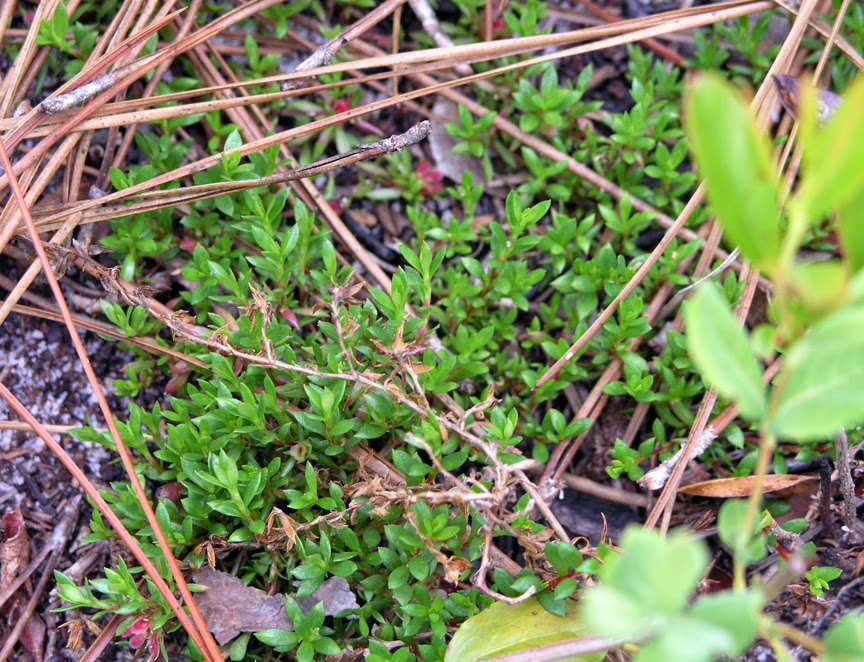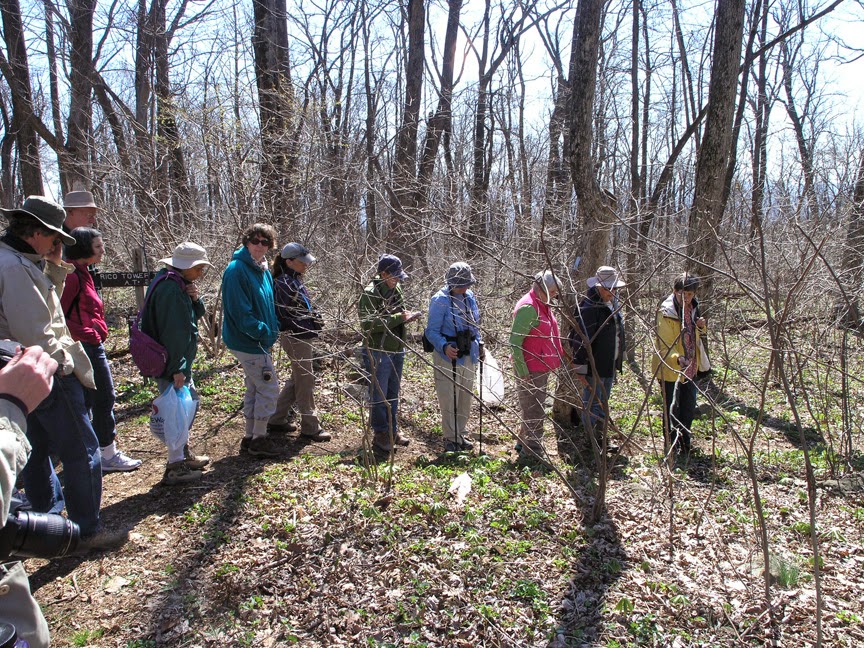 |
| Cleistes bifaria |
Last weekend my friend Linda and I traveled to North Carolina to join the
North Carolina Native Plant Society (NCNPS) on their annual
Green Swamp excursion. Since this has been a very late spring and all plants are about 2-3 weeks later than usual, I had expected that we would not see some of the blooms I'd hoped for. In fact, we did not see the famous Rosebud orchid (
Cleistes divaricata), but we did find some blooms of its smaller cousin
Cleistes bifaria (above), an equally lovely sight.
We arrived too late on Friday evening for the roadside botanizing in the vicinity of Whiteville, NC, so on Saturday morning our guides took those of us who had missed that on to the roadside sites first. A huge storm system in the area (covering Virginia as well) had dumped over three inches of rain two days before, and as we left my house in Front Royal, the first two holes on the golf course at the entrance were under water.
As we learned, these areas of NC are usually wet anyway--we had to wade ankle-deep into a roadside ditch to reach our first site. Linda and I had brought only old shoes, so despite our best efforts to avoid sinking, there was no help for it. Once over the initial chill of the water, it was just fine. Later on in the day, in the heat of the afternoon, our soggy shoes felt even better.
 |
| Sundew (Drosera intermedia) |
Our first sightings were sundews, small insectivorous plants:
Drosera capillaris (very tiny),
Drosera intermedia (above) and
Drosera filiformis, a slightly taller variety, growing in the muck among spagnum moss. Pitcher plants (
Sarracenia sp.) were plentiful, and we encountered several varieties in flower:
S. rubra,
S. flava, and
S. minor. Our guide, David McAdoo, pointed out something fascinating--the spots along the top and back of the hooded pitchers are actually transparent "windows" that allow sunlight to reach the inner surface of the pitcher plant for photosynthesis.
 |
| Hooded pitcher plant (Sarracenia minor). |
 |
| Blooms of Sarracenia minor. |
 |
| Sarracenia flava. |
There were Venus Flytraps here and there, the small plants were hard to see among the grasses. And other lovely spring flowers too, purple Skullcap and a very pretty orange clover-like one whose name I didn't note down, bracken and cinnamon ferns. Also Butterworts (
Pinguicula), club mosses and plants so numerous I couldn't write them all down.
 |
| Skullcap (Scutellaria intergrifolia?) |
I didn't get a single photo of the lovely Lady's tresses orchid (Spiranthes praecox) in focus--there was also a flower spike very similar to Lady's tresses from a distance, white colic root (Alestris farinosa) which ironically, I did better with. One has to look closely-- in Spiranthes as its name implies, the tiny orchid flowers grow in a spiral form around the scape.
 |
| Colic root (Aletris farinosa) |
 |
| Rose Pogonia (Pogonia ophioglossoides) |
Rose Pogonia orchid grew at this site in small clumps along the ditch. After about an hour and a half here, it was time to drive on to our second stop, the Billboards--a grassy elevation sandwiched between four billboards. Heading south on 130, there were so many other billboards it would have been hard to figure out which four were the right ones, if we hadn't been caravaning.
 |
| The Billboards. |
 |
| Sarracenia rubra. |
 |
| Venus flytrap (Dionaea muscipula) |
 |
| Sarracenia purpurea. |
Here were more pitcher plants in profusion,
S. rubra,
S. purpurea, and
S. flava, Venus Flytraps (
Dionaea muscipula) in bud and flower, Sweet Bay and Maleberry (
Lyonia), which looks very like a blueberry. Farther down, finally, were a few of the orchids I'd come so far to see:
Cleistes bifaria and one specimen of
Calopogon pallidus (the pale Grass Pink). It was hard to photograph the flowers blowing in the breeze, but I managed to get a couple of decent shots.
 |
| Calopogon pallidus |
 |
| Side view of Calopogon |
From my orchid studies I've learned that most orchids are resupinate, which means the flowers are rotated on their stems to be updside down, so the lip (labellum) is at the bottom of the flower. This arrangement provides a landing pad for the pollinating insect. Calopogon orchids are the exception, as you can see from the photo, the labellum is positioned above the petals and sepals. Instead, the hairs on the labellum function as a lure for the insect, and when a bee tries to lands on them, its weight causes the hinged labellum to swing down and position the bee onto the column for pollination.
We left the Billboards around noon and headed south to Shallotte for a bathroom break at the local Popeyes. We ate our box lunches in the parking lot. After lunch it was finally time to visit the Green Swamp. The Green Swamp is actually not a swamp so much as a long-leaf pine savannah or "pocosin," the native American name for these local wetlands. They have acidic, peaty, poorly-drained soils that are
oligotrophic, meaning nutrient-deficient, which is probably why so many of the plants found in this environment are carnivorous. The Green Swamp is noted for its amazing diversity of plants, over 50 different species have been counted in about a one square meter plot. We entered an area known as the Big Island Savannah by crossing another deep watery ditch.
 |
| Entering the Green Swamp |
Our first sighting was a narrow-leaf Milkweed (
Asclepsias longifolia), and more pitcher plants of S. flava and S. purpurea.
 |
| Narrow leaf Milkweed (Asclepsias longifolia) |
After a while we drove on to another part of the Green Swamp where the scent of Swamp Azaleas (Rhododendrum viscosum) pervaded the air--thickets carpeted the shady parts of the savannah, and swallowtail butterflies flitted about. We came across one rather beat-up Grass Pink orchid (
Calopogon barbatus?) but my single shot was not in focus .I hoped we'd come across a couple more specimens but that was the only one I saw.
 |
| Swamp Azalea (Rhododendrum viscosum) |
After we left the Green Swamp we drove on to another site at Boiling Spring
Lakes, where the most incredible display of Rose Pogonias I've ever seen stretched for
what seemed like a mile along a ditch. According to our accompanying botanists, the Pogonia spreads by underground rhizomes, and here it had obviously enjoyed many years (hundreds?) of uninterrupted growth to cover such an expanse.
 |
| Rose Pogonias near Boiling Springs Lakes. |
 |
| Rose Pogonias grow among Spagnum moss and ferns |
 |
| Rose Pogonia (Pogonia ophioglossiodes) |
By this time the second battery for my camera was running low, and I was trying to conserve power, so I limited the number of my shots--with an extra battery I could have gone on to take hundreds of photos here.
Our last site of the day was yet another roadside ditch where the Venus
flytraps seemed to be unusually red in color--perhaps the lack or
addition of a particular nutrient? There were several more
Cleistes
bifaria orchids in bloom here, but at this point, my camera battery
finally gave out. After covering so much ground in one day we were tired, so it
was time to head back to Whiteville to clean up and rest before dinner at the Forestry Museum and the native plant auction.
 |
| Venus Flytrap (Dionaea muscipula) |
 |
| Blooms of Venus Flytrap |
North Carolina has the most fascinating roadside ditches I've ever seen! Next time I'm here, I'll bring pair of oystering boots or Wellingtons. Sunday morning at Lake Waccamaw will have to be a separate posting, as this is already way too long.
For more photos see my Flicker album
here.



























































